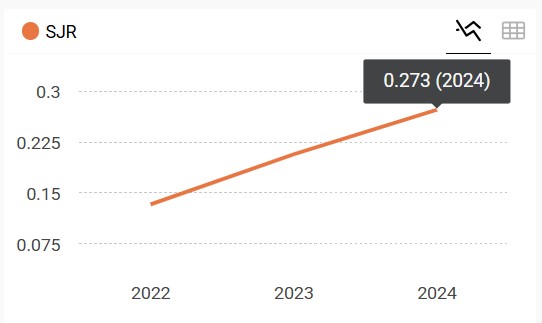Exploring the usefulness of the Brief COPE in clinical and positive psychology: A discriminant content validity study
DOI:
https://doi.org/10.21580/pjpp.v8i1.15063Keywords:
discriminant content validity, coping strategies, dysfunctional coping, emotion-focused coping, problem-focused copingAbstract
The Brief Coping Orientation to Problem Experienced (COPE) scale is widely used for measuring coping strategies. However, concerns persist regarding the dimensions captured by the scale and the accuracy of item representation. This study examined the relevance of adapted Brief COPE items using discriminant content validity (DCV). A panel of experts (n = 15) assessed the extent to which the items corresponded to their intended dimensions. Intraclass correlation (ICC) estimates ranged from 0.640 to 0.828, indicating agreement among experts. A one-sample t-test evaluated DCV, revealing that 21 out of 28 items distinctly and exclusively measured intended dimensions, confirming their discriminant content validity. Seven items were excluded: three did not measure coping strategies (non-dimension), and four measured them in different dimensions (wrong-dimension). The discriminant content-validated Brief COPE scale improves coping assessment, benefiting psychological therapies and providing researchers with refined measures for each coping strategy dimension, addressing dimensional concerns.Downloads
References
American Educational Research Association, American Psychological Association, National Council on Measurement in Education, J. C. on S. for E. and P. T. (U. S. ). (2014). Standards for educational and psychological testing. Washington, DC : AERA.
Angelica, K., Sukamto, M. E., Chandra, C. C., & Andrea, K. (2022). Coping strategies to predict the psychological well-being of college students during the COVID-19 pandemic. Humanitas: Indonesian Psychological Journal, 19(August), 148–160. https://doi.org/10.26555/humanitas.v19i2.49
Biggs, A., Brough, P., & Drummond, S. (2017). Lazarus and Folkman’s Psychological Stress and Coping Theory. In The Handbook of Stress and Health. https://doi.org/10.1002/9781118993811.ch21
Borualago, I. S., & Casas, F. (2021). Subjective Well-Being of Indonesian Children: A Perspective of Material Well-Being (Kesejahteraan Subjektif Anak Indonesia: Sebuah Perspektif Kesejahteraan Materi). ANIMA Indonesian Psychological Journal, 26(2), 204–230. https://doi.org/10.1515/9783111634487-006
Bose, N. C., Bjorling, G., Elfstrom, M. L., Persson, H., & Saboonchi, F. (2015). Assessment of Coping Strategies and Their Associations With Health Related Quality of Life in Patients With Chronic Heart Failure: the Brief COPE Restructured. Cardiology Research, 6(2), 239–248. https://doi.org/10.14740/cr385w
Bukhori, B., Ma’arif, S., Panatik, S. A. B., Siaputra, I. B., & Al Afghani, A. A. (2022). A Study on Muslim University Students in Indonesia: The Mediating Role of Resilience in the Effects of Religiosity, Social Support, Self-Efficacy on Subjective Well-being. Islamic Guidance and Counseling Journal, 5(2), 152–171. https://doi.org/10.25217/igcj.v5i2.2972
Carver, C. S. (1997). You want to measure coping but your protocol’s too long: Consider the brief COPE. International Journal of Behavioral Medicine, 4(1), 92–100.
Carver, C. S., Scheier, M. F., & Weintraub, K. J. (1989). Assessing Coping Strategies: A Theoretically Based Approach. Journal of Personality and Social Psychology, 56(2), 267–283. https://doi.org/10.1037/0022-3514.56.2.267
Faisal, A. (2019). Pengaruh strategi coping, social support dan faktor demografis terhadap psychological well-being mahasiswa perantau Universitas Islam Negeri Syarif Hidayatullah Jakarta. UIN Syarif Hidayatullah Jakarta.
Fredrickson, B. (2001). The Role of Positive Emotions in Positive Psychology The Broaden - and Build Theory of Positive Emotions. American Psychologist, 56(3), 218–226. https://doi.org/doi:10.1037/0003-066x.56.3.218
García, F. E., Barraza-peña, C. G., Wlodarczyk, A., Alvear-carrasco, M., & Reyes-reyes, A. (2018). Psychometric properties of the Brief-COPE for the evaluation of coping strategies in the Chilean population. Psicologia: Reflexão e Crítica, 31(22), 1–11.
Hernandez, A., Hidalgo, M. ., Hambleton, R. ., & Gómez-Benito, J. (2020). International test commission guidelines for test adaptation: A criterion checklist. Psicothema, 32(3), 390–398. https://doi.org/https://doi.org/10.7334/psicothema2019.306
Huda, N., Lin, Y.-K., Shaw, M. K., & Chang, H. J. (2022). Psychometric properties and cross-cultural adaptation of the Indonesian version of the Brief COPE in a sample of advanced cancer patients. Annals of Oncology, 32, S1275. https://doi.org/10.1016/j.annonc.2021.08.683
Huda, N, Yun-Yen, Deli, H., Shaw, M. K., Huang, T. W., & Chang, H. J. (2021). Mediation of Coping Strategies among Patients with Advanced Cancer. Clinical Nursing Research, 30(8), 1153–1163. https://doi.org/10.1177/10547738211003276
Huda, Nurul, & Chang, H. . (2020). Coping strategies and functional status among patients with advanced cancer in Indonesia. Annals of Oncology, 31(4).
International Test Commission. (2017). ITC guidelines for translating and adapting tests (2nd ed). Retrieved from www.InTestCom.org
Johnston, M., Dixon, D., Hart, J., Glidewell, L., Schröder, C., & Pollard, B. (2014). Discriminant content validity: A quantitative methodology for assessing content of theory-based measures, with illustrative applications. British Journal of Health Psychology, 19(2), 240–257. https://doi.org/10.1111/bjhp.12095
Johnston, M., & Pollard, B. (2001). Consequences of disease: testing the WHO International Classification of Impairments, Disabilities and Handicaps (ICIDH) model. Social Science & Medicine (1982), 53(10), 1261–1273. https://doi.org/https://doi.org/10.1016/s0277-9536(00)00384-1
Kamarulbahri, T. M. S. T., Ariaratnam, S., Nikmat, A. W., Abdullah, N. N., & Khing, T. L. (2022). Coping strategies and their associated factors among caregivers of patients with schizophrenia in Kuantan, Malaysia. Frontiers in Psychiatry, 13. https://doi.org/10.3389/fpsyt.2022.1004034
Kato, T. (2015). Frequently used coping scales: A meta-analysis. Stress and Health, 31(4), 315–323. https://doi.org/10.1002/smi.2557
Lazarus, R. S., & Folkman, S. (1984). Stress, Appraisal, and coping (1st ed.). New York: Springer Publishing Company, Inc.
Lazarus, R. S., & Folkman, S. (1987). Transactional theory and research on emotions and coping. European Journal of Personality, 1(3), 141–169. https://doi.org/10.1002/per.2410010304
Leman, H. K., & Arjadi, R. (2023). Self-Criticism in Emerging Adulthood With Adverse Childhood Experiences Increases Depression, Anxiety, and Stress [Kritik Diri Pada Dewasa Awal Dengan Pengalaman Buruk di Masa Kecil Meningkatkan Depresi, Kecemasan, dan Stres]. ANIMA Indonesian Psychological Journal, 38(1), 038108. https://doi.org/10.24123/aipj.v38i1.4893
Matsumoto, S., Yamaoka, K., Nguyen, H. D. T., Nguyen, D. T., Nagai, M., Tanuma, J., … Oka, S. (2020). Validation of the Brief Coping Orientation to Problem Experienced (Brief COPE) inventory in people living with HIV/AIDS in Vietnam. Global Health & Medicine, 2(6), 374–383. https://doi.org/10.35772/ghm.2020.01064
Monzani, D., Steca, P., Greco, A., D’Addario, M., Cappelletti, E., & Pancani, L. (2015). The situational version of the brief COPE: Dimensionality and relationships with goal-related variables. Europe’s Journal of Psychology, 11(2), 295–310. https://doi.org/10.5964/ejop.v11i2.935
Peters, R. M., Solberg, M. A., Templin, T. N., & Cassidy-Bushrow, A. E. (2020). Psychometric Properties of the Brief COPE Among Pregnant African American Women. Western Journal of Nursing Research, 42(11), 927–936. https://doi.org/10.1177/0193945920907686
Prasetyawati, W., Rifameutia, T., Gillies, R., & Newcombe, P. (2021). The Adaptation of a Brief Adolescent Subjective Well-Being in School Scale (BASWBSS), the Student Subjective Well-Being Scale in the Indonesian Context [Adaptasi BASWBSS, Skala Kesejahteraan Subjektif Siswa dalam Konteks Indonesia]. ANIMA Indonesian Psychological Journal, Vol. 36, pp. 184–203. https://doi.org/10.24123/aipj.v36i2.2277
Putri, M. C. . (2012). Hubungan antara coping dan psychological distress pada istri yang mengalami kekerasan dalam rumah tangga. Fakultas Psikologi Universitas Indonesia.
Rahman, H. A., Bani Issa, W., & Naing, L. (2021). Psychometric properties of brief-COPE inventory among nurses. BMC Nursing, 20(1), 1–7. https://doi.org/10.1186/s12912-021-00592-5
Schmitt, M. A., Schröder, C. D., Stenneberg, M. S., van Meeteren, N. L. U., Helders, P. J. M., Pollard, B., & Dixon, D. (2013). Content validity of the Dutch version of the Neck Bournemouth Questionnaire. Manual Therapy, 18(5), 386–389. https://doi.org/10.1016/j.math.2013.01.004
Seligman, M. E., & Csikszentmihalyi, M. (2000). Positive psychology. An introduction. The American Psychologist, 55(1), 5–14. https://doi.org/10.1037/0003-066X.55.1.5
Shepard, L. . (2016). Evaluating test validity: reprise and progress. Assessment in Education: Principles. Policy & Practice, 23, 268–280.
Solberg, M. A., Gridley, M. K., & Peters, R. M. (2022). The Factor Structure of the Brief Cope: A Systematic Review. Western Journal of Nursing Research, 44(6), 612–627. https://doi.org/10.1177/01939459211012044
Søvold, L. E., Naslund, J. A., Kousoulis, A. A., Saxena, S., Qoronfleh, M. W., Grobler, C., & Münter, L. (2021). Prioritizing the Mental Health and Well-Being of Healthcare Workers: An Urgent Global Public Health Priority. Frontiers in Public Health, 9(May), 1–12. https://doi.org/10.3389/fpubh.2021.679397
Veirman, E., van Ryckeghem, D. M. L., Verleysen, G., de Paepe, A. L., & Crombez, G. (2021). What do alexithymia items measure? A discriminant content validity study of the Toronto-alexithymia-scale–20. PeerJ, 9, 1–21. https://doi.org/10.7717/peerj.11639
Yeni, A. R., & Pelupessy, D. C. (2023). National Resilience in Regards to Drug Problems: The Effects of Perceived Threat and Sense of Coherence [National Resilience Dalam Masalah Narkoba: Pengaruh Perceived Threat dan Sense of Coherence]. ANIMA Indonesian Psychological Journal, 38(1), 038110. https://doi.org/10.24123/aipj.v38i1.5206
Yuniardi, M. S., Rodgers, J., & Freeston, M. H. (2022). Comparison of Alcohol and Cannabis Motives and Context of Use among United Kingdom Students. ANIMA Indonesian Psychological Journal, 37(1), 19–37. https://doi.org/10.24123/aipj.v37i1.2531
Yusoff, M. S. B. (2011). The Validity of the Malay Brief Cope in Identifying. International Medical Journal, International Medical Journal (March 2011), 29–33.
Downloads
Published
How to Cite
Issue
Section
License
The copyright of the accepted article shall be assigned to the publisher of the journal. The intended copyright includes the right to publish the article in various forms (including reprints). The journal maintains the publishing rights to published articles.
In line with the license, authors and any users (readers and other researchers) are allowed to share and adapt the material only for non-commercial purposes. In addition, the material must be given appropriate credit, provided with a link to the license, and indicated if changes were made. If authors remix, transform, or build upon the material, authors must distribute their contributions under the same license as the original.



